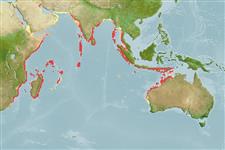Common names from other countries
>
Tetraodontiformes (Puffers and filefishes) >
Balistidae (Triggerfishes)
Etymology: Melichthys: Greek, melas, melaina, melan, black + icthys yos, fish. On the other hand, in Smith et al.,1986: 878), 'body dark brown to black' in https://www.biodiversitylibrary.org/item/266635#page/902/mode/1up.(P. Romero, pers.comm. 03/2022)..
More on authors: Randall & Klausewitz.
Environment: milieu / climate zone / depth range / distribution range
Ökologie
seewasser riff-verbunden; tiefenbereich 1 - 30 m (Ref. 9710). Tropical
Indian Ocean: Red Sea and East Africa eastward to western Thailand and Indonesia.
Size / Gewicht / Alter
Maturity: Lm ? range ? - ? cm
Max length : 25.0 cm TL Männchen/unbestimmt; (Ref. 4420)
Rückenflossenstacheln (insgesamt): 3; Rückenflossenweichstrahlen (insgesamt): 30-35; Afterflossenstacheln 0; Afterflossenweichstrahlen: 27 - 30. Narrow white margin round caudal fin; live specimens bluish or violet (Ref. 4420).
Inhabits coral-rich seaward reef slopes (Ref. 9710, 48637). Occurs singly (Ref. 9710). Digs holes below coral bases for shelter (Ref. 48637). Feeds on sponges, algae, crustaceans and small invertebrates (Ref. 5503). Caught with artisanal gear (Ref. 30573). Minimum depth from Ref. 58018.
Life cycle and mating behavior
Geschlechtsreife | Fortpflanzung | Ablaichen | Eier | Fecundity | Larven
Oviparous, distinct pairing during breeding (Ref. 205).
Smith, M.M. and P.C. Heemstra, 1986. Balistidae. p. 876-882. In M.M. Smith and P.C. Heemstra (eds.) Smiths' sea fishes. Springer-Verlag, Berlin. (Ref. 4420)
IUCN Rote Liste Status (Ref. 130435)
CITES (Ref. 128078)
Not Evaluated
Bedrohung für Menschen
Harmless
Nutzung durch Menschen
Aquarium: Kommerziell
Mehr Information
ReferenzenAquakulturAquakultur ProfilZuchtlinienGenetikElectrophoresesVererbbarkeitKrankheitenVerarbeitungMass conversion
PartnerBilderStamps, Coins Misc.LauteCiguateraGeschwindigkeitSchwimmstilKiemenoberflächeOtolithsGehirngrößeSehfähigkeit
Tools
Zusatzinformationen
Download XML
Internet Quellen
Estimates based on models
Preferred temperature (Ref.
115969): 25.4 - 29.3, mean 28.2 (based on 947 cells).
Phylogenetic diversity index (Ref.
82804): PD
50 = 0.6250 [Uniqueness, from 0.5 = low to 2.0 = high].
Bayesian length-weight: a=0.02570 (0.01232 - 0.05364), b=2.94 (2.77 - 3.11), in cm Total Length, based on LWR estimates for this (Sub)family-body shape (Ref.
93245).
Trophic level (Ref.
69278): 3.0 ±0.29 se; based on food items.
Widerstandsfähigkeit (Ref.
120179): hoch, Verdopplung der Population dauert weniger als 15 Monate. (Preliminary K or Fecundity.).
Fishing Vulnerability (Ref.
59153): Low vulnerability (15 of 100).
